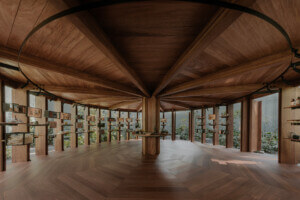A new international airport for Mexico City won’t just fix the problems of its predecessor—which typically delays planes because the two runways were built too close together—it will be unique in its efficient expansive single enclosure, according to its architects, Foster + Partners and FR-EE.
Foster and FR-EE were announced as the winners of a design competition last Tuesday, in which all the finalists had worked with local design talent. Mexico City-based FR-EE’s founder Fernando Romero is married to Soumaya Slim, a daughter of Mexican tycoon Carlos Slim.
The new airport, which aims to become the busiest in Latin America, has received a $9.17 billion pledge, partly in public land from President Enrique Peña Nieto. The government will finance its early construction, issuing bonds for later stages of development. Officials estimate Mexico will receive $19.6 billion in additional tourism revenue through 2040 as a result of the new airport. It will accommodate more than 100 million annual passengers.
At more than 6 million square feet, the new airport will be one of the world’s largest. It’s also labeling itself the most sustainable. While still a complex committed to promoting air travel, a substantial contributor to global emissions of carbon dioxide, its layout is intended to be entirely walkable and won’t need heating or air conditioning for most of the year. Foster + Partner’s website said the project will be LEED Platinum:
The entire building is serviced from beneath, freeing the roof of ducts and pipes and revealing the environmental skin. This hardworking structure harnesses the power of the sun, collects rainwater, provides shading, directs daylight and enables views—all while achieving a high performance envelope that meets high thermal and acoustic standards.
Organized around a single massive enclosure, the airport weaves cavernous, naturally ventilated spaces around an organic “X” shape that appears in plan like a cross section of DNA. The lightweight, pre-fab structure will open its first three runways by 2020. Another three runways, set to open by 2050, will quadruple the airport’s current capacity.
Mexico City’s current airport, Benito Juárez International, will eventually be closed and rehabbed into a commercial development and public park.
The design competition that preceded this week’s unveiling drew high-profile names, including Zaha Hadid, Richard Rogers, and Pascall+Watson. Mexican-American architect and partner at JAHN, Francisco Gonzalez-Pulido, also submitted a design to the competition, but was ultimately unsuccessful. He teamed up with local designers Francisco Lopez-Guerra of LOGUER and Alonso de Garay of ADG for the airport, whose form evokes both flight and traditional Mexican art. A pyramidal arrangement of structural white “umbrellas” transmit light while shielding occupants from the hot Mexican sun.










